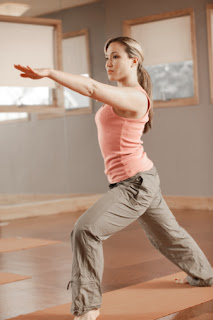Ashtanga Vinyasa is an asana based yoga practice that stresses daily Vinyasa flow practice, ujjayi breathing, which is breathing from the core, and the practice of uddiyana bandha. The benefit of Ashtanga yoga is that it can be practiced at any pace so those looking for a vigorous workout can go for a long routine, filled with complex poses and quick transitions, whereas someone looking for a more meditative practice can go through the motions slowly, with smooth transitions, concentrating on the breathing. The benefits of Ashtanga include increased flexibility and increased overall strength.
Power yoga is a modern practice focused on high intensity physical work outs with fast paced transitions and complicated positions. Power yoga is not for the novice practitioner. Following in the footsteps of Ashtanga, power yoga includes the Vinyasa flow practice, ujjayi breathing and many similar poses. The difference between Ashtanga and power yoga is that power yoga is meant to be more of a work out or exercise class than a traditional practice, focusing on strength building and increased flexibility. Power yoga is great for those looking to increase their flexibility, decrease chronic pain and improve their physical health.
Click here to see our online Yoga Nidra teacher training course.
Are you an experienced teacher looking for YACEP credits or continuing education?
Subscribe to Our Newsletter for Special Discounts and New Products
Related Resources
52 Essential Principles of Yoga Philosophy to Deepen your Practice
by Rina Jakubowicz.
A Relaxing Way to De-stress, Re-energize, and Find Balance
by: Gail Boorstein Grossman.
YOGA: THE PATH TO HOLISTIC HEALTH
by B.K.S. Iyengar
TEACHING YOGA: Essential Foundations and Techniques
By Mark Stephens

